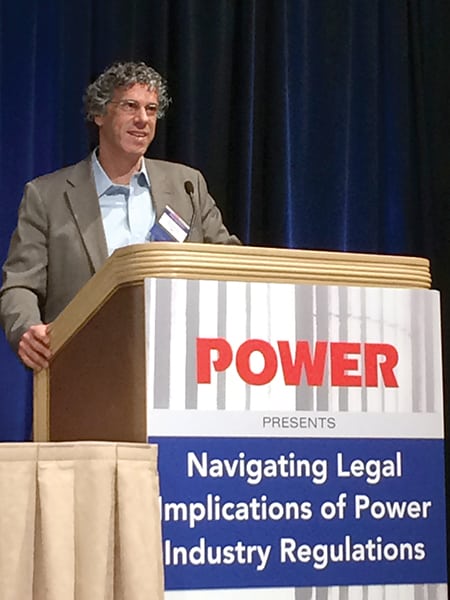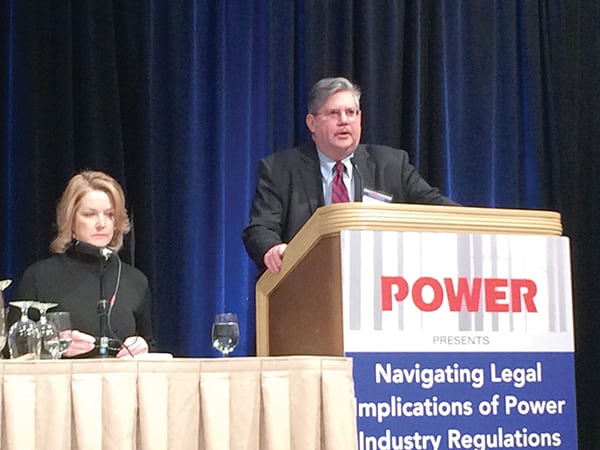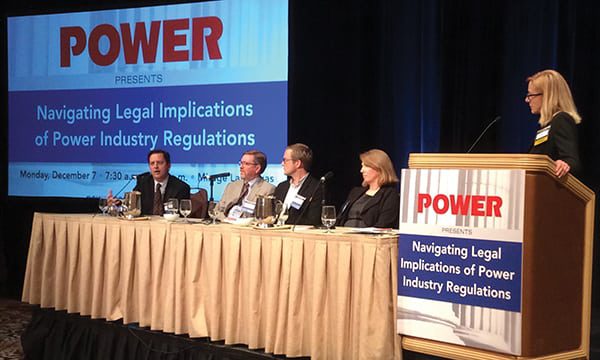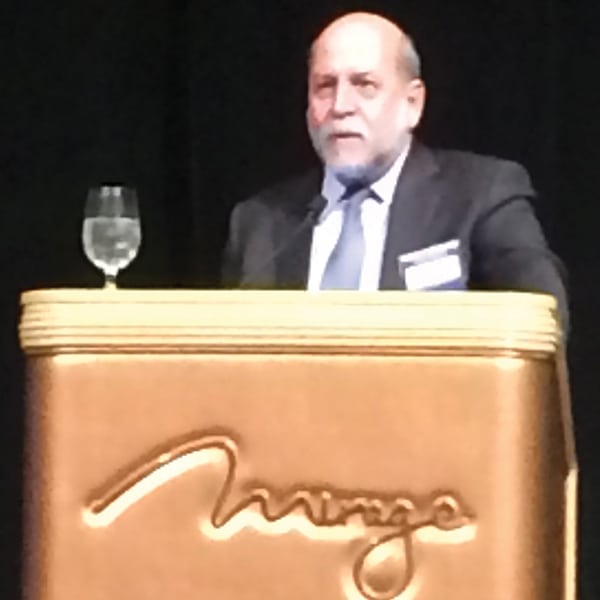Navigating Legal Implications of Power Industry Regulations
Current and former Environmental Protection Agency lawyers as well as seasoned energy and environmental lawyers in private practice shared their insights, projections, and advice at POWER’s legal affairs conference.
From the U.S. Environmental Protection Agency’s (EPA’s) top lawyer to attorneys who have argued cases against the agency’s regulations, all the speakers at POWER’ s December 7 legal affairs conference in Las Vegas, Navigating Legal Implications of Power Industry Regulations, agreed that taking a wait-and-see approach to compliance with recent federal regulations is ill-advised. As EPA General Counsel Avi S. Garbow (Figure 1) said in his opening keynote address, “they’re all final rules,” and it would be “wrong and risky” to treat them as uncertain, even when subject to legal challenge.
EPA General Counsel Puts Regulations in Context
Garbow, clearly aware of the way many in the power industry view his agency, made an effort to explain that the EPA is not the freewheeling, unaccountable agency it is often made out to be. Rather, it is tightly constrained by a welter of often-conflicting statutes and court decisions that frequently leave it little choice in the direction it goes. “In most cases,” Garbow said, “the agency does not have discretion not to act.”
The statutes the EPA operates under—including the Clean Air Act (CAA), Clean Water Act (CWA), and other laws—were created separately, at separate times, under differing priorities and political environments. Most of them have also been amended repeatedly. “The agency has to figure out ways for these to work together,” he said.
Garbow asked event attendees—representatives of generating companies, engineering and consulting firms, law firms, and equipment providers—to view the EPA “as a reasonable partner” even if they don’t agree with the agency. He said he hoped industry experts would “tell us what we don’t know” in order to test the EPA’s own legal analysis, and he observed that the millions of comments on the Clean Power Plan (CPP) have increased its legal defensibility.
Garbow also stressed that the EPA is not out to handicap the free market. Rather, it tries to find ways to meet its statutory mandates in ways that work economically. “My hope is that none of you see environmental protection as the antithesis of economic progress,” he said.
During the question and answer period, Garbow was asked about reliability issues and said that states can revise their CPP implementation plans if they face significant reliability challenges.
Litigating Climate Change Issues
The U.S. has long been known for its litigious environment, so perhaps it shouldn’t be surprising that it’s even outpacing other jurisdictions in the new area of climate change litigation. More lawsuits concerning climate change have been decided or settled in the U.S. than in the rest of the world combined, explained Teri Donaldson, partner with DLA Piper, although “the success rate in these cases is very low.”
“Climate change is pushing the courts to do things that the courts are not empowered to do, and the courts are resisting that. They are declining to legislate, so the success rate internationally is about 40%,” she added.
Donaldson also addressed the recent news concerning ExxonMobil, its climate change research, and what it did and didn’t tell shareholders. “From the perspective of a former federal prosecutor, I am here to tell you what is going on in the securities side is insane. It’s out of control. It’s something that you do need to keep an eye on and be fearful of, in a way, because I’ve never seen anything quite like this,” she said.
The Securities and Exchange Commission issued guidance in 2010 on what a company should tell shareholders to expect as a result of climate change. It pointed out that much more information is publicly available outside of disclosure statements, but it also laid out expectations for companies to cover the impact of legislation and regulations in their annual report filings. In essence, companies are being asked to look into a crystal ball and guess what could happen in the future, with the possibility of being held responsible for inaccurate predictions.
“There are potential consequences that are not only expensive in terms of defending an investigation, but there is also the potential for criminal penalties for your inability to have an accurate crystal ball, and I think that’s really alarming,” Donaldson said.
With no adequate legal framework in place to combat climate change in the U.S., about all companies can do is keep fighting litigation that seeks to misuse the laws and the courts. Donaldson suggested that state and federal lawmakers must be pressed into action to do their jobs and pass suitable legislation.
Litigation Alone Is Short-Sighted
Michael G. Cooke of Greenberg Traurig (Figure 2) advised that states need to focus on state implementation plans (SIPs) for the CPP and not just litigation. States must submit SIPs by September 6, 2016. A two-year extension can be requested, but annual progress reports are required, and final SIPs must be submitted by September 6, 2018.
Cooke examined the situations faced by two states, Maryland and Florida, to contrast their current circumstances.
Florida is a traditionally regulated state and essentially an isolated grid. The state’s preliminary analysis suggested that significant coal-fired generation might have to be retired as a result of the CPP and that capacity challenges could be created. It expects a continued shift to natural gas–fired generation, which already makes up 65% of the state’s portfolio. Some estimates are that natural gas will rise as high as 85% by 2025, making the state very dependent on one type of fuel.
Maryland, a deregulated state, also expects the rule to result in the retirement of some coal capacity, but it expects to rely on a multistate trading approach with continued emphasis on renewable portfolio standards (RPSs) to address the challenge. Maryland has a much more diversified fuel mix—44% coal, 38% nuclear, 9% natural gas, 5% hydro, 1% oil, and 3% other—so even with some change, it will be far less dependent on a single fuel source.
Unintended Consequences of Multiple EPA Rules
Floyd Self (Figure 3), an attorney with Berger Singerman, said that the collection of new EPA rules have helped forge mergers between electric and gas utilities and necessitated new natural gas pipelines. They have also prompted the consolidation of energy production and may bring about the demise of small utilities. “As cheap natural gas and environmental compliance accelerate, we need to question whether smaller utilities can ultimately survive, especially municipalities and co-ops,” he said.
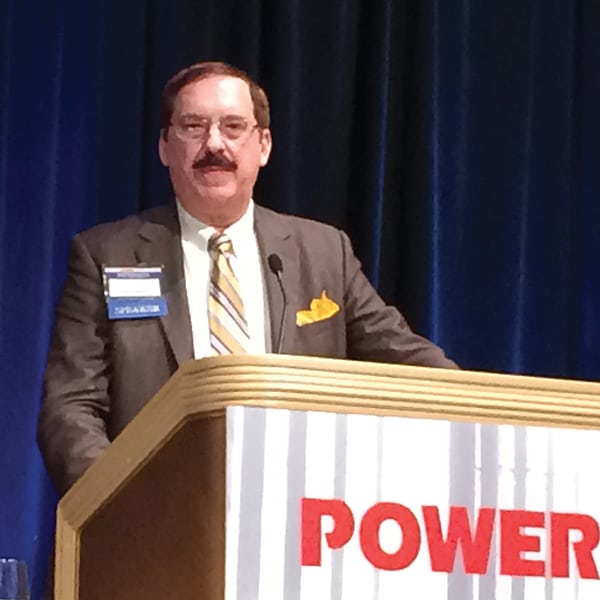 |
|
3. Consolidation ahead? Floyd Self of Berger Singerman predicted the pressure of recent regulations may force some smaller utilities to merge with larger ones. Source: POWER/Gail Reitenbach |
Self noted that munis and co-ops are heavily invested in coal and have a lot of debt. “I don’t know,” he said, “if some of these smaller utilities will have the scope or scale that will enable them to successfully get out of debt to make that transition over to natural gas. In my mind, the only way that some of these smaller utilities can ultimately comply is if they merge with other larger utilities.”
Attorney Tom Boer from Hunton & Williams (Figure 4) outlined key aspects of the final CWA 316(b) rule (the Cooling Water Intake rule), which became effective October 14, 2015. It already has legal challenges filed in the First, Second, Fourth, Fifth, Sixth, Seventh, and Ninth Circuit courts of appeal. Those challenges have been filed by regulated industry and trade associations, which argue that compliance will cost hundreds of millions of dollars, as well as by environmental groups, which argue that the rule isn’t sufficiently protective to meet CWA requirements.
 |
|
4. Don’t forget the water rule. Tom Boer from Hunton & Williams addressed legal challenges to the 316(b) Cooling Water Intake rule. Source: POWER/Gail Reitenbach |
That rule is likely to be overturned, Boer said, though the EPA will undoubtedly post an iteration that will replace it. Boer advised industry to prepare to comply with the 316(b) rule as a best business practice.
Responding to the Clean Power Plan
The longest session of the day was devoted to the Clean Power Plan (Figure 5). Discussing the opening round of litigation against the CPP, Allison Wood, a partner with Hunton & Williams, noted that there are signs that the Supreme Court is beginning the view the EPA’s actions with a more skeptical eye. She urged attendees to pay close attention to other EPA cases before the CPP finally reaches the court in a few years.
Wood, who was part of the team of lawyers representing the utility sector in the landmark case of Massachusetts v. EPA, which opened the door to carbon dioxide (CO2) regulation, suggested the Supreme Court does not see that case as an open-ended license. It’s clear from recent cases, such as Utility Air Regulatory Group v. EPA in 2014 that the court is mindful of not letting the EPA stray beyond its statutory authorization in regulating emissions. That is significant, Wood said, because of the arguments CPP opponents are making that the plan is outside the EPA’s authority under the CAA.
Patrick Ferguson, a partner with Davis Wright Tremaine, noted that much of the future of the CPP depends on state choices for compliance and whether they decide to submit a plan at all. States that submit a SIP will have the most control over how to approach compliance. He noted that several of the states suing the EPA have nevertheless begun work on their SIP.
But political opposition is so intense in some states that SIPs may not be feasible—or even legal. Several state legislatures have passed or are considering measures barring regulators from submitting a SIP. For those states, regulators may have no choice but to accept a Federal Implementation Plan (FIP).
States designing a SIP need to choose between mass-based (total emissions reductions) and rate-based (statewide pounds of CO2/MWh) goals. Rate-based goals are more flexible, Ferguson noted, but mass-based goals may be simpler to implement. The EPA is encouraging emissions trading, but the CPP does not allow trading between states using different approaches.
Ferguson said multi-state trading plans are likely to be more efficient and effective in the long run, based on existing experiments such as the Regional Greenhouse Gas Initiative (RGGI). Existing programs like RGGI are actually well ahead of the curve and on track to meet CPP goals by 2020. California, as a result of its aggressive RPS, will also be well beyond its goal by 2030. That will leave these states ample room for trading with other states.
Svend A. Brandt-Erichsen, managing partner at Marten Law, drew attention to what he called the “big idea” behind the CPP. The EPA sees fuel substitution between coal, gas, and renewables taking place every day across the grid for economic reasons. What it wants to do is interpret “best system of emissions reduction” in the CAA to require the same sorts of dispatch choices for environmental reasons.
Brandt-Erichsen sees the potential for some significant interstate tensions. He discussed the examples of Oregon, Washington, and Montana. The first two states support the CPP, while Montana is suing to block it. Oregon and Washington each have only one coal plant that will soon shut down. Both states have enough other renewable and gas-fired capacity to survive the closures, which also give them enough room under their goals to build new generation.
Montana, by contrast, has several large coal plants and a steep 47.4% emissions reduction goal. The retirement of the Corette plant this year will help, but Montana still needs to make steep cuts in its coal generation, mostly at the 2-GW Colstrip plant. But there’s a problem for state regulators: The largest share of the obligation for reductions will fall on the Oregon- and Washington-based utilities that own and operate most of Colstrip’s capacity, he noted.
Some states like Oregon and Washington may see sufficient renewables growth to meet the targets, but that won’t be the case everywhere. Brandt-Erichsen suggested the EPA’s projections for growth were “highly optimistic” and asked, “What happens if renewable energy growth is not enough to meet the demand?”
Jim McTarnaghan, a partner with Perkins Coie, offered an observation that he suggested explains much of the texture of support and opposition to the CPP. A map of the states suing and supporting the plan, when colored red and blue, “looks a lot like the state-by-state maps of the last two presidential elections.”
States that support the plan, like California, tend to have some things in common: aggressive RPSs, gas-heavy power mixes, and voters who are sensitive to climate change issues and support measures to address it. States opposing the plan tend to be coal heavy and populated by voters who are concerned about impacts on coal industry jobs. There’s a real sense in the “anti” states that the rule is not being applied equally and fairly, McTarnaghan noted.
All four panelists agreed that some level of interstate cooperation was inevitable given the degree to which the CPP encourages it. The FIP—likely to be imposed on many states—Ferguson noted, is “trading ready,” meaning that even states opposed to the plan may have little choice about participating in regional solutions.
What Lies Ahead?
In his luncheon keynote address, Robert Meyers of Crowell & Moring, and former head of the EPA’s Office of Air and Radiation, offered his projections for energy policy, regulation, and litigation (Figure 6). “Is this an inflection point for energy policy?” he asked rhetorically, before pointing to the combination of recent reports on the potential for decarbonization, the Paris climate change talks taking place the same week as POWER’ s event, and the “slow-moving trainwreck” of multiple power plant–related regulations.
Meyers predicted that it will be very difficult to keep the CPP on schedule and suggested that even if a Democrat wins the White House in the November elections, there may be changes to recent regulations. “A regulatory ‘pause’ is likely in either case,” he said, based on past presidential transitions.
That said, in the Q&A period, Meyers noted that the CPP is a final rule, and the odds of a stay are poor, in his opinion, so states and generators need to be involved in the development of SIPs. If he were a generator, he said, he would be talking to his state regulator and governor right now. “You’ve got to deal with it now,” he underscored, “and if you get more time, you’re lucky.”
More detailed coverage of this event was provided in online news stories at powermag.com the week of December 7.
— Aaron Larson, Thomas W. Overton, JD, and Sonal Patel are POWER associate editors. Gail Reitenbach, PhD is POWER’s editor.
